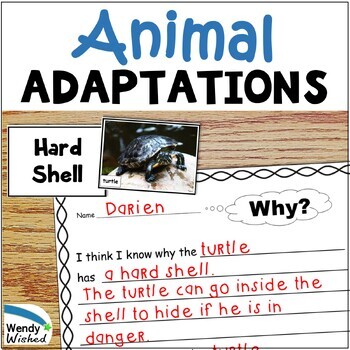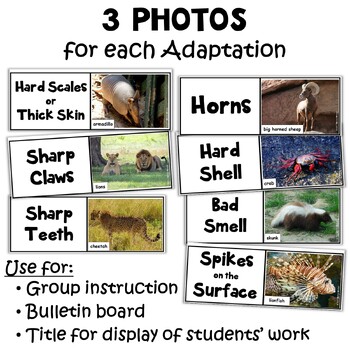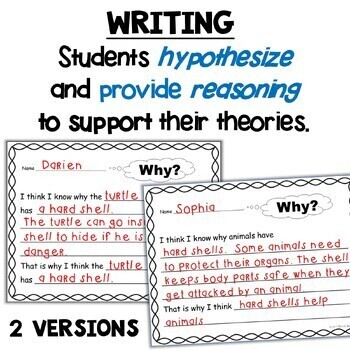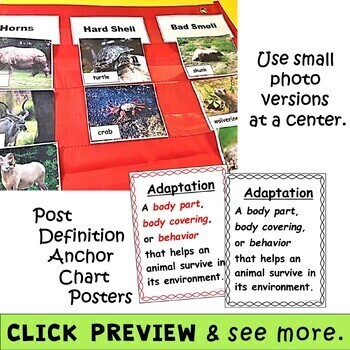Animal Adaptations Activities for Structure and Function of Inherited Traits
- PDF
What educators are saying
Also included in
- Need resources to help you teach both plant AND animal adaptations? Get ready to focus on the Next Generation Science Standard regarding traits, adaptations, and structures and functions that help animals AND plants survive. Teach your students to observe the external parts, hypothesize how thesePrice $7.60Original Price $9.50Save $1.90
Description
Combine science and writing with this activity about animal external body parts. Introduce your first grade students to the Next Generation Science Standard* regarding inherited traits, animal adaptations, and structures and functions that help animals survive. Your students will observe, think, predict, and write. Just share the photos of real animals. Students will discuss the body parts and hypothesize why the animals have them. How does that help the animal survive? Brainstorm ideas. Then students will complete a persuasive and opinion writing activity stating their reasons and ideas. Supplement your science curriculum or focus on the writing activity.
Just imagine how many standards and goals you will address with your class.
- Science
- Speaking & Listening - discussing photos
- Language - for new vocabulary
- Persuasive and Opinion Writing
Click on the green "VIEW PREVIEW" button above to see what is included in this resource.
Buy the BUNDLE, SAVE 20%, and get everything you need for the complete ANIMAL & PLANT unit. Click the blue link to see the entire unit.
Included in your download:
- a full page definition of adaptation in color and just black & white (You can use the colorful version as an anchor chart and the black and white one for students to post in their science journal, folder, etc.)
- 6 full page collage of animals displaying one trait. Traits include: spikes on surface, sharp teeth, hard shell, horns, sharp claws, and hard scales/thick skin. Plus bad smells.
- 2 versions of writing pages to explain WHY students think the animal has the adaptation that helps them survive
- a list of websites with helpful information to help you answer all of those questions students ask
- Also included are lesson plan sequence and teaching tips. I outline how to introduce the concepts. Ideas for getting the students up and moving are included.
Let me tell you more:
Get the lessons started by using one of the six pages of photo collages . (I added a bonus "Bad Smells" page. Not a body part but it is made by a body part. Just imagine how your class will react when you discuss this card! I bet they will remember this lesson.) Each page highlights one body part or feature along with three animals that possess it and survive because of it.
Through discussion, your students will learn about these important physical structures as well as broaden their knowledge of animals. Then guide them to use higher order thinking skills to hypothesize why the animals have these traits.
Now let them write about what was discussed. Two writing pages are provided for them to identify the animal's trait and justify their thinking as to why this helps the animal survive.
Teaching Tips:
- I recommend that you start out with a shared writing activity completing one with the whole class, This will provide modeling of how to think up reasons, write details, and complete the writing page to your expectations.
- You can then let students work in pairs having them pick another trait and animal to write about.
- Finally, each student can complete their own individually. This completes a "I do, we do, you do (teacher model, work with a partner and then on your own)" method of gradual release of responsibility.
- You can even place this in a center after the initial demonstration/modeling lesson. Students can complete one trait or every trait using the writing pages provided.
Enjoy teaching science this year.
If you have wished for a resource,
you might find it in my store - Wendy Wished
★☆★☆★☆★☆★☆★☆★☆★☆★☆★☆★☆★☆★☆★☆★☆★☆★☆★☆★☆★☆★☆★☆★☆★☆★☆★☆★☆★☆
Your purchase grants you permission for single classroom and personal use only.
Give a REVIEW and get FREE TPT Credits:
- Go to your “My Purchases” & just comment with a “Review”. Then save money on your next TpT purchase.
★☆★☆★☆★☆★☆★☆★☆★☆★☆★☆★☆★☆★☆★☆★☆★☆★☆★☆★☆★☆★☆★☆★☆★☆★☆★☆★☆★☆
© Copyright Wendy Wished. All rights reserved by author. This product is to be used by the original purchaser only. Copying for more than one teacher or classroom, or for an entire grade level, team, school, or school system is prohibited. This product may not be distributed or displayed digitally for public view, uploaded to school or district websites, distributed via email, or submitted to file sharing sites. Failure to comply is a copyright infringement and a violation of the Digital Millennium Copyright Act (DMCA).
*Next Generation Science Standards (“NGSS”) is a registered trademark of Achieve. Neither Achieve nor the lead states and partners that developed the Next Generation Science Standards were involved in the production of this product, and do not endorse it.






